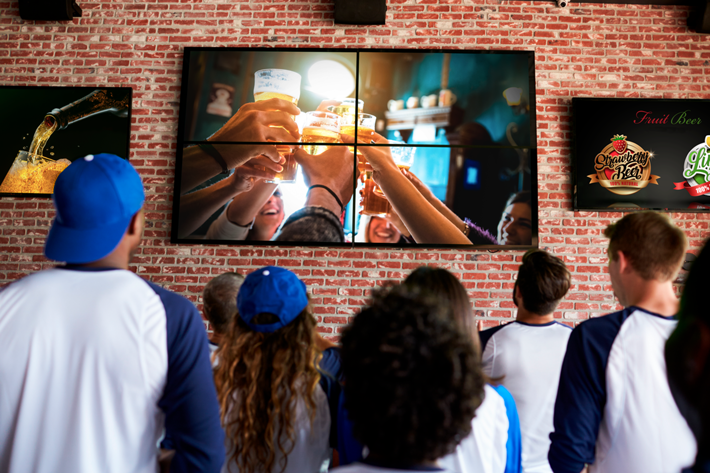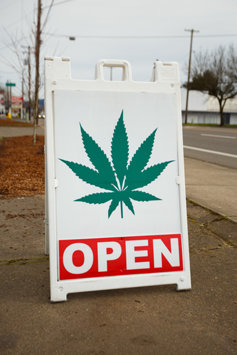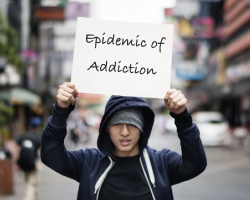Why Do We Allow Advertising for Addictive Products?

Certainly, there have been efforts to curtail advertising of products that were destined to make people either sick or had a significant likelihood of making many addicted—for example, tobacco. In the 1960s, tobacco companies were heavy supporters of radio, television, and magazines. Then in 1970, television advertising was banned. In 1997 and 2010, more restrictions were imposed. Smoking dropped from 65% of the adult population to 17% today.
So why do we allow other addictive, harmful substances to be advertised?
A Little History
Alcohol Advertising
Alcohol advertising has gone through a series of limitations over the years. Amazingly, this industry has been allowed to determine its own restrictions. Beer manufacturers, for example, promise to only run their ads on television shows with audiences that are composed of at least 71.6% adults of legal drinking age. Makers of distilled spirits use the same guidelines when choosing advertising at live events.
For many years, hard spirits weren’t advertised on television at all, but in 2012 the networks relaxed their rules and allowed hard liquor ads during predominantly adult broadcasts, such as late-night television. In 2018, alcoholic beverage companies invested $253.8 billion in advertising their products. This was an increase of $12.4 billion over the prior year.
“Underage drinkers and adult pathological drinkers… consume between 37.5% and 48.8% of the value of all alcohol sold in the United States.”

Why? To attract customers, of course. And who are their best customers? In 2006, a report in the Archives of Pediatrics and Adolescent Medicine hit the nail exactly on the head: “Underage drinkers and adult pathological drinkers… consume between 37.5% and 48.8% of the value of all alcohol sold in the United States.”
So, young drinkers. (Get them started early and they’ll be drinkers for life!) And those who can’t control their drinking. These are also the groups most likely to suffer harm from drinking. Young drinkers risk harm such as alcohol poisoning, accidents, assaults and traffic fatalities. Chronic drinkers risk dozens of different physical problems ranging from heart disease to cancer and cirrhosis of the liver.
Prescription Drug Advertising
In 1969, the U.S. Food and Drug Administration authorized drug companies to begin advertising their products directly to patients, not just to doctors. In 1981, direct-to-consumer (DTC) advertising launched with a Merck ad for a pneumonia vaccine. The floodgates were open and hundreds of thousands more ads followed.
In 1997, with the increased loosening of regulations, $1.2 billion was spent on these ads. By 2016, that number had reached $6 billion. That price tag covered 4.6 million ads, including 663,000 television commercials.
Perhaps this advertising had some minor benefits, for example, informing the public of possible solutions to illnesses. But the ads certainly began to indoctrinate Americans on all the drugs they could take for anything that ailed or pained them. The Institute For Research, Education and Training in Addictions states: “Overall, it appears that DTC ads have been a contributor—by no means the only contributor—to a cultural shift whereby normal feelings are pathologized and taking drugs from your doctor is both safe and normal. It is a shift that has definite implications for addiction and substance use disorders.”
The Present Day
It’s very possible that most people are so used to drug advertising on every side that they don’t even notice the ads they are exposed to. Here are some ads you may pass by every day:
- A liquor store with posters in every window advertising specials
- A restaurant with a chalkboard outside promoting two-for-one beer specials
- Spring Break ads sponsored by breweries on college websites
- Notepads or pens with drug names printed on them
- Liquor ads on billboards, especially around the holidays
- Liquor ads in magazines
- Beer ads on television during sporting events, plus more ads in the stadium
I did an analysis of a popular woman’s magazine that seemed to have a high number of drug ads in it. Actually, though it seemed like a high number of ads, it had the same number of drug ads as many other women’s magazines. I purchased a copy of this magazine and tore out all the prescription drug advertisements. When I was done, I found that the magazine had 136 pages plus four covers (inside and outside) and 24 full pages of ads for pharmaceutical drugs. That means that 17% of the magazine was devoted to drug ads. Over and above these ads, more pages were devoted to over-the-counter medications.
Marijuana

Are you in a state with legalized medical or recreational marijuana? Then you’re probably seeing these things that promote the presence and use of this drug:
- Dispensaries and retail stores sprinkled through your town
- Billboards advertising special deals on marijuana
- Signs and ads advertising “marijuana docs” who will provide medical recommendations for marijuana
- Magazine and newspaper ads, especially in alternative lifestyle publications
- Individuals standing on the side of the road waving signs directing people to a marijuana retailer
More People Profiting from Addictive Substances
You may see even more ads dedicated to marketing products that address the side effects of prescription or illegal products. During Super Bowl 50 in 2016, there was an ad for a new product that alleviated “opioid-induced constipation.” In other words, if you were taking opioids legitimately or illegitimately, this new formula would alleviate the constipation that resulted. The makers of the opioid antidote naloxone and companies that provide Suboxone or other buprenorphine products likewise profit from the human tragedy that is addiction.
Food for Thought
Beer breweries and spirit distilleries have been part of the culture for thousands of years. In comparison, marijuana is a relative newcomer. Since the Big Experiment of Prohibition in the early 1900s, we know that didn’t work. But is it right to plaster our cities with encouragement to consume addictive products?
In 2015, Starbucks locations began adding alcoholic beverages to its menus. In Whole Foods stores, you can get a latte, a beer or glass of wine and drink it as you wander around the store. When these offerings began to appear, I was angry on behalf of those in recovery from alcoholism who previously could sip coffee or shop without being within arm’s reach of alcohol.
Perhaps there’s a couple of questions we should ask ourselves. It’s not hard to find places to get these addictive substances. Does advertising encourage more people to drink, smoke or take pills? Would it be healthier for society to omit such advertising and not encourage people to make harmful choices? Perhaps these are matters we should give some thought to.
Sources:
- https://www.politico.com/story/2018/04/01/congress-bans-airing-cigarette-ads-april-1-1970-489882
- https://www.bw166.com/2019/01/13/u-s-beverage-alcohol-spending-hits-253-8-billion-in-2018-5-1-versus-2017/
- https://www.beerinstitute.org/wp-content/uploads/2018/12/BEER-6735-2018-Beer-Ad-Code-Update-Brochure-for-web.pdf
- https://www.distilledspirits.org/wp-content/uploads/2018/03/May_26_2011_DISCUS_Code_Word_Version1.pdf
- https://www.centeronaddiction.org/newsroom/press-releases/2006-apam-commercial-value-of-underage-drinking
- https://www.narconon.org/drug-abuse/signs-symptoms-alcohol-use.html
- https://www.narconon.org/drug-abuse/marijuana/identifying-abuse.html
- https://jamanetwork.com/journals/jama/fullarticle/2720029
- https://www.narconon.org/drug-abuse/signs-symptoms-prescription-drug-use.html
- https://ireta.org/resources/pills-for-your-ills/
- https://money.cnn.com/2015/08/18/news/companies/starbucks-alcohol/
- https://www.retailcustomerexperience.com/articles/commentary-whole-foods-drink-while-you-shop-plan-wont-work-for-most-retailers/


 ®
®